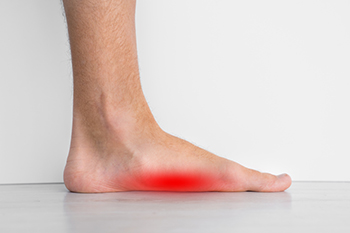 Parents can help their children prevent foot problems and associated pain as they age by taking care of and teaching their children to take proper care of their feet. Developing healthy foot habits in children starts with parents washing their children’s feet each day and making sure they are dry, buying shoes that fit properly (with enough room in the toe box to allow for growth), using right sized cotton and/or wool socks on children’s feet to keep them warm and allow room for development, cutting toenails straight across and not too short to prevent ingrown toenails, and allowing children to go barefoot in the home so their feet will grow and gain strength without restriction. Taking children to a podiatrist early on can start them off right, provide a baseline for their foot development, and introduce them to a specialist who will be able to diagnose and treat any foot problems that might arise in their lives.
Parents can help their children prevent foot problems and associated pain as they age by taking care of and teaching their children to take proper care of their feet. Developing healthy foot habits in children starts with parents washing their children’s feet each day and making sure they are dry, buying shoes that fit properly (with enough room in the toe box to allow for growth), using right sized cotton and/or wool socks on children’s feet to keep them warm and allow room for development, cutting toenails straight across and not too short to prevent ingrown toenails, and allowing children to go barefoot in the home so their feet will grow and gain strength without restriction. Taking children to a podiatrist early on can start them off right, provide a baseline for their foot development, and introduce them to a specialist who will be able to diagnose and treat any foot problems that might arise in their lives.
Making sure that your children maintain good foot health is very important as they grow. If you have any questions, contact one of our podiatrists of Canonsburg Podiatry Associates. Our doctors can provide the care you need to keep you pain-free and on your feet.
Keeping Children's Feet Healthy
Having healthy feet during childhood can help prevent medical problems later in life, namely in the back and legs. As children grow, their feet require different types of care. Here are some things to consider...
Although babies do not walk yet, it is still very important to take care of their feet.
Avoid putting tight shoes or socks on his or her feet.
Allow the baby to stretch and kick his or her feet to feel comfortable.
As a toddler, kids are now on the move and begin to develop differently. At this age, toddlers are getting a feel for walking, so don’t be alarmed if your toddler is unsteady or ‘walks funny’.
As your child gets older, it is important to teach them how to take care of their feet.
Show them proper hygiene to prevent infections such as fungus.
Be watchful for any pain or injury.
Have all injuries checked by a doctor as soon as possible.
Comfortable, protective shoes should always be worn, especially at play.
If you have any questions please feel free to contact our office located in Canonsburg and McMurray, PA . We offer the newest diagnostic and treatment technologies for all your foot and ankle needs.





